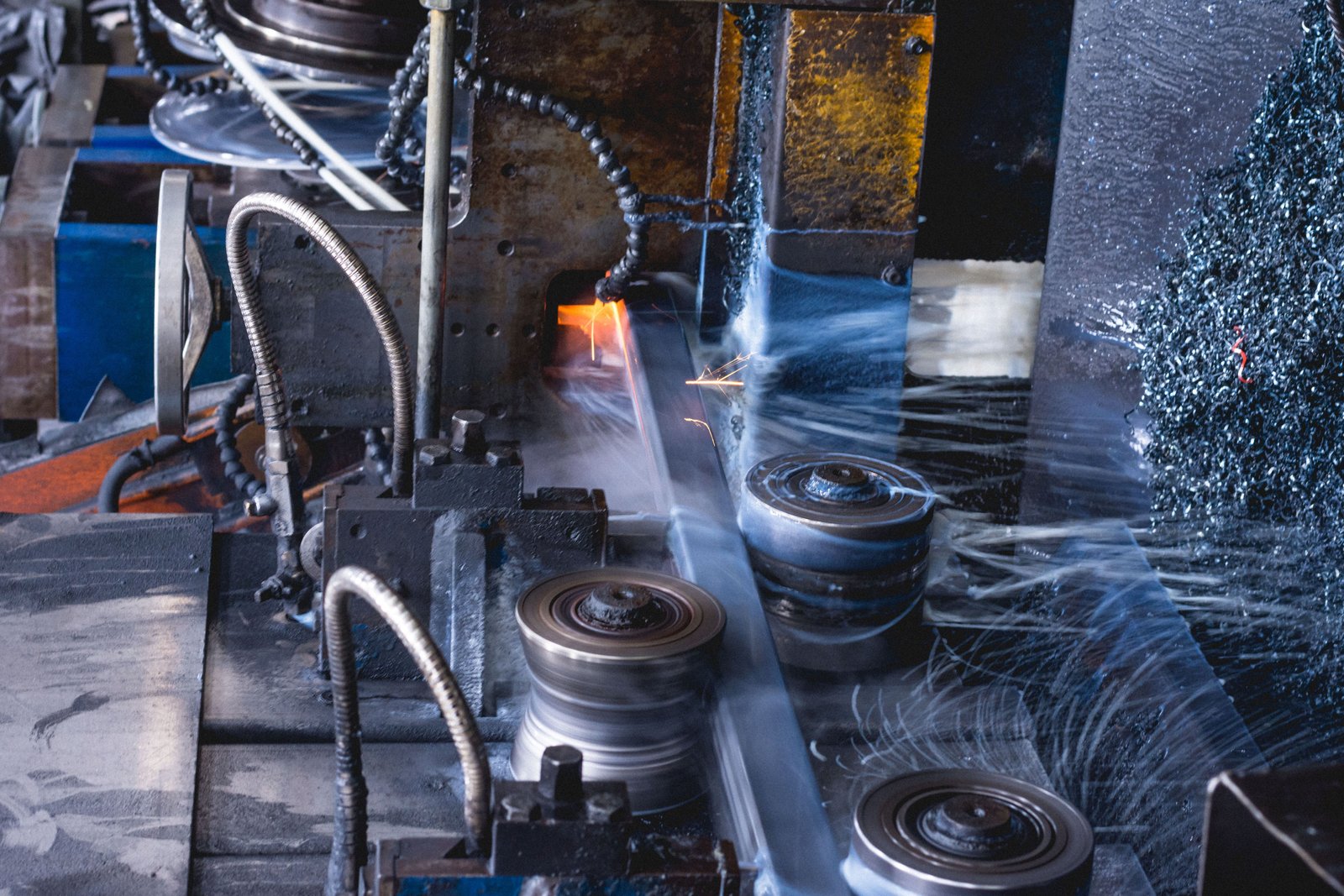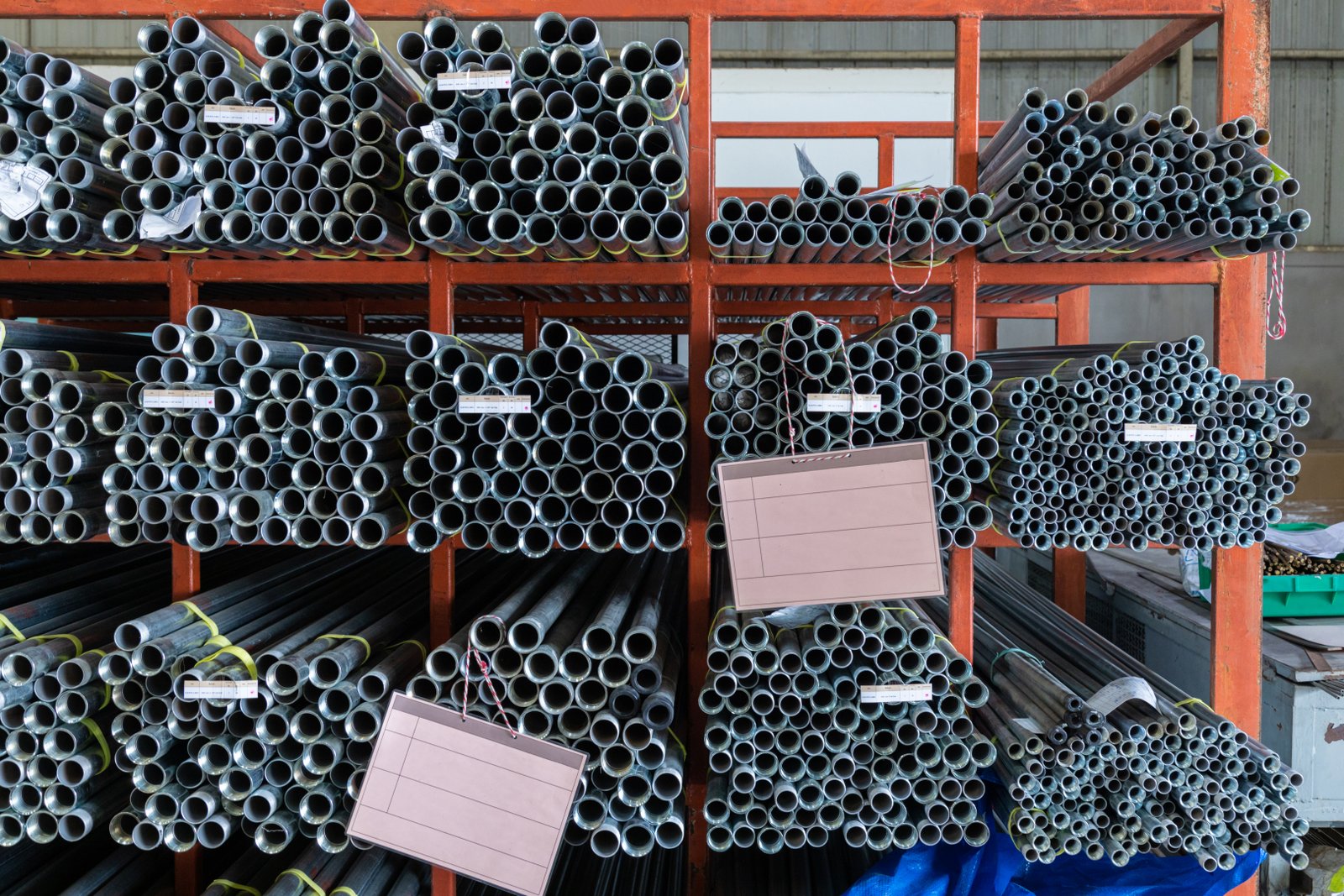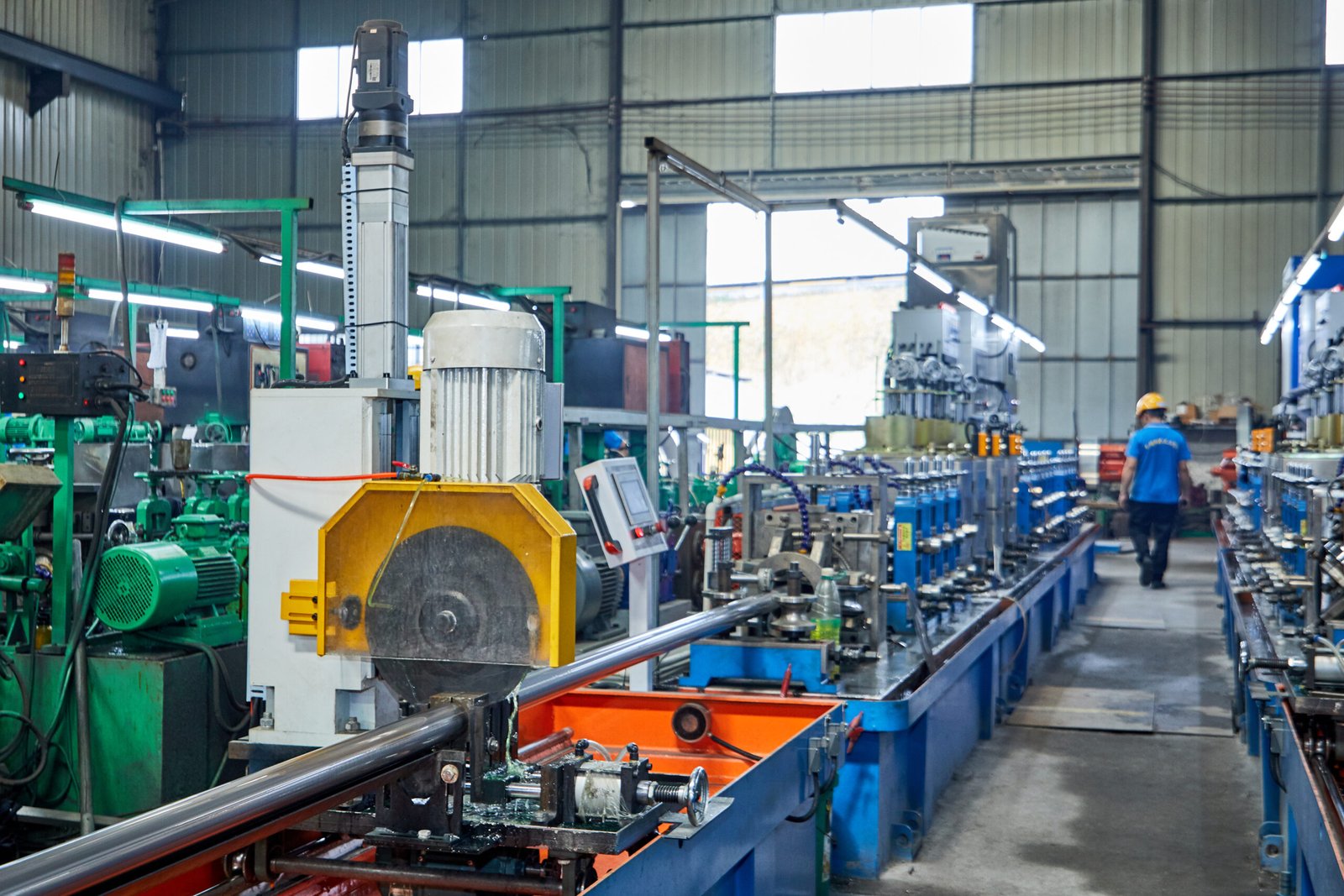Digital Mill Certificates & Blockchain Traceability in Pipe Supply Chains

Are you still wrestling with cumbersome paper trails, risking project delays over a single lost document? The manual verification of mill test certificates is a major bottleneck, exposing your supply chain to fraud and costly errors, ultimately eroding trust and profits in a highly competitive global market. At MFY, we believe there's a better way.
Digital mill certificates and blockchain traceability are revolutionizing pipe supply chains by replacing insecure paper records with a secure, immutable, and transparent digital ledger. This enhances material verification, drastically reduces fraud risk, and accelerates logistics, creating unprecedented trust and efficiency from the mill to the final installation.
This transition from paper to a digitally-native trust system isn't just a technological upgrade; it's a fundamental strategic shift. As global supply chains become more complex and customers demand greater transparency, the ability to instantly verify the authenticity and specifications of every component is no longer a luxury—it's a requirement for survival and growth. This isn't about chasing trends; it's about mitigating risk, enhancing operational agility, and building a supply chain that's resilient enough for the challenges of tomorrow.
The move towards full digital traceability is not without its hurdles, but the potential rewards are immense. It requires a new way of thinking, moving beyond the simple digitization of old processes and embracing a system where data integrity1 is cryptographically guaranteed. In this article, I'll draw upon my experience at MFY, working with partners across Asia and the Middle East, to explore this evolution—from the historical context of paper certificates to the practical steps for integrating blockchain technology effectively. We will look at the real-world challenges, the proven strategies for adoption, and the ultimate vision of a fully transparent supply chain.
What is the historical context of mill certificates in pipe supply chains?
Remember the days of dusty filing cabinets overflowing with paper mill test certificates (MTCs)? Locating a specific document for a project audit from years ago was a logistical nightmare. This reliance on physical paper created significant friction and risk in an increasingly fast-paced industry.
Historically, mill certificates were foundational paper documents that traveled with steel pipe shipments, serving as the sole proof of material composition, mechanical properties, and compliance with international standards. While essential for quality assurance, these physical records were highly susceptible to loss, damage, and fraudulent alteration.
The paper MTC was, for decades, the bedrock of trust in our industry. It was a tangible promise from the mill to the end-user, a sworn statement of quality that you could hold in your hand. This system was born in an era of more localized supply chains and slower-paced projects. However, as our world globalized and project timelines compressed from years to months, the inherent weaknesses of this analog system became glaringly obvious. I recall a situation with a new construction contractor in India who was working on a time-sensitive power plant build. They were facing a crucial audit, and a single MTC for a batch of our 304L stainless steel pipes had been misplaced. The entire project timeline was threatened by this one missing piece of paper. We were able to expedite a verified copy from our archives, but the incident was a wake-up call for our client. It powerfully illustrated that in the modern supply chain, the speed and integrity of information are just as critical as the physical delivery of the goods themselves. This experience, and many others like it, catalyzed the industry's slow but steady shift toward digital alternatives.

The journey of the mill certificate is a story about the evolution of trust itself. For decades, that trust was vested in paper, ink, and official stamps. This system, while functional for its time, was fraught with inefficiencies and risks that are simply unacceptable in today's digital-first world. Understanding this history is crucial to appreciating the profound nature of the shift towards blockchain.
The Era of Paper-Based Assurance
In the post-war industrial expansion, as global trade began to flourish, the need for standardized quality verification became paramount. Organizations like ASTM, ASME, and EN established the specifications that defined materials for critical applications. The Mill Test Certificate (MTC), or Mill Test Report (MTR), was born out of this need. It was more than just a spec sheet; it was a legal document, a certified record from the manufacturer attesting that a specific batch, or "heat," of steel met the required chemical and physical properties.
The physical process was laborious. After a heat of steel was produced and tested, a technician in a quality assurance lab would record the results. This report was then typed up, signed, and stamped by an authorized inspector. This piece of paper began a long journey, often placed in a plastic sleeve and attached to shipping manifests. It would be handled by freight forwarders, customs agents, warehouse managers, and finally, the end customer's quality inspector, who would file it away in a cabinet, where it might sit for years until an audit or inquiry.
This entire chain of custody was based on the perceived integrity of the document. The trust was in the letterhead, the signature, the stamp. It was a system built for an analog world, and its limitations were an accepted cost of doing business. The potential for human error in transcription, the risk of a document being lost in transit, and the slow pace of verification were all considered normal.
The Emergence of Analog Vulnerabilities
As supply chains grew longer and more complex, these accepted costs became unacceptable risks. The analog system's vulnerabilities became a source of significant financial and reputational damage. Forgery became a major concern. With modern printing technology, replicating a company's letterhead and forging a signature became disturbingly easy, opening the door for substandard or counterfeit materials to enter the supply chain disguised as premium products.
I remember a case we consulted on for a large equipment integrator. They had unknowingly purchased a batch of pipes with falsified MTCs from a dubious trader. The material failed under pressure testing, forcing a costly recall and project delay. The financial loss was significant, but the damage to their reputation was even greater. Beyond outright fraud, the system was plagued by inefficiency. A 2018 report by a supply chain consortium noted that manual document handling and verification accounted for up to 15% of the total administrative time in an international shipment.
This inefficiency directly translated to delays and costs. If a customer in Dubai needed to double-check a certificate's authenticity, they would have to contact us in China. Accounting for time zones and communication chains, a simple verification could take days. In a world of just-in-time manufacturing and tight construction schedules, these delays were—and are—untenable. The physical nature of the document was its greatest weakness.
Regulatory and Market Drivers for Digitization
The final push away from paper came from two primary forces: stricter regulations and evolving market expectations. In critical sectors like oil and gas, nuclear power, and pharmaceuticals, regulatory bodies began demanding more robust and readily accessible traceability. The days of accepting a faded photocopy were over. An audit in these sectors now requires a clear, verifiable chain of custody for every single component.
Simultaneously, the market itself began to change. Large-scale EPC (Engineering, Procurement, and Construction) contractors, our key clients, started implementing their own sophisticated digital Quality Management Systems (QMS). To even bid on a project, suppliers like us were increasingly required to provide documentation in a digital format that could be easily integrated into these systems. A PDF scan was the first step, but it was merely a digital picture of an analog process. The data wasn't "alive"; it couldn't be automatically parsed or analyzed.
This created the perfect storm. The old paper system was too slow, too risky, and incompatible with the digital workflows of modern business. The initial shift to sending PDFs via email solved the speed problem but did little to address the core issues of security and data integration. It was a temporary patch on a systemic issue. This set the stage for the next evolutionary step: truly smart, secure, and verifiable digital certificates.
| Feature | Paper Mill Test Certificate (MTC) | Scanned/PDF Digital Certificate |
|---|---|---|
| Verification | Manual, requires contacting the mill | Manual, still requires contacting the mill |
| Security | Low (easily forged or altered) | Low (PDFs can be edited) |
| Transferability | Physical courier, slow | Instant via email, fast |
| Data Integration | None, requires manual data entry | Limited, requires OCR or manual entry |
| Storage | Physical archives, prone to loss/damage | Digital files, requires server space/backup |
| Authenticity | Based on trust in the paper/stamp | Based on trust in the email source |
Paper MTCs were easily forgedTrue
Modern printing technology made it simple to replicate company letterheads and signatures, enabling counterfeit materials to enter supply chains.
PDF certificates solved security issuesFalse
While PDFs improved transfer speed, they remained vulnerable to editing and didn't address core authentication problems of paper certificates.
How are digital mill certificates currently utilized in the industry?
Tired of the uncertainty that comes with PDF attachments and scanned documents? While a step up from paper, these "digital paper" formats still lack true security and data intelligence, leaving your operations vulnerable to errors and clever forgeries in a sophisticated market.
Currently, digital mill certificates are most commonly utilized as PDF files sent via email, offering speed but limited security. More advanced applications include QR code systems linking to secure web portals for verification and direct integration with client ERP or QMS systems for automated data capture.
The move from paper to digital has been gradual, and the "current state" is a mosaic of different technologies and adoption levels. While some companies are still reliant on simple scans, others are pushing the boundaries of what's possible. At MFY, we've embraced a proactive approach, recognizing that providing accessible and verifiable data is a competitive advantage. For instance, we worked with a major distributor in Southeast Asia who services hundreds of smaller fabrication shops. They were struggling to manage the sheer volume of MTC requests. By implementing a QR code system on our pipe bundles, we empowered their team and their customers to self-verify material authenticity in seconds using a smartphone. This didn't just save administrative time; it built a deeper layer of trust and transparency in our partnership. This practical application demonstrates the tangible benefits of moving beyond static PDFs. However, this is just one piece of the puzzle. The true power of digital certificates is unlocked when they become more than just a document and transform into a dynamic data asset that can be integrated deep into a company's operational fabric.

The current landscape of digital mill certificates is a spectrum of sophistication. It ranges from basic digital replicas of paper to highly integrated data streams that drive quality control and procurement processes. Examining these methods reveals a clear evolutionary path towards a more secure and intelligent future.
The Baseline: PDFs as "Digital Paper"
The most common form of digital MTC today is the Portable Document Format (PDF). When a certificate is generated at the mill, it is saved or scanned as a PDF and emailed to the client along with the invoice and shipping documents. This method solved the most immediate problem of the paper era: speed. A document can now travel across the globe in an instant, eliminating courier delays and the risk of physical loss in transit.
However, this approach is little more than a digital photograph of the old process. It carries many of the same vulnerabilities. A standard PDF can be easily edited with widely available software, allowing bad actors to alter chemical compositions or change testing dates with a few clicks. Verification still relies on trust in the sender or requires the recipient to initiate a manual confirmation process by contacting the mill.
Furthermore, the data within the PDF is "trapped." It cannot be easily ingested by a computer system. A receiving inspector or a quality manager must still manually transcribe the values from the PDF into their company's Enterprise Resource Planning (ERP) or Quality Management System (QMS). This manual data entry is a significant source of errors, which can lead to incorrect material classification, compliance issues, and production mistakes downstream. While better than paper, the PDF is a transitional technology that fails to address the core needs of security and data interoperability.
The Intermediate Step: QR Codes and Secure Portals
A more advanced and secure utilization involves linking the physical product to a secure digital certificate via a QR code. This is a system we have successfully implemented at MFY. Each pipe, or bundle of pipes, is marked with a unique, durable label containing a QR code. When scanned with any standard smartphone or tablet, this code directs the user to a secure, non-public page on our corporate website (www.mfysteel.com).
On this portal, the user can view the authentic, unalterable MTC directly from our master database. This simple act provides several powerful advantages. First, it decouples the certificate from insecure channels like email. The "single source of truth" is our secure server, not a potentially doctored attachment. Second, it provides instant, on-the-spot verification. A client's receiving inspector on the warehouse floor, a customs agent at the port, or a contractor at a job site can verify authenticity in seconds.
We had a client, an equipment integrator for the food and beverage industry in Russia, who faced skepticism from their end-customer about the grade of 316L stainless steel they were supplying. Using our QR system, their project manager was able to scan the pipe on-site, pull up the MFY-hosted certificate, and instantly prove compliance, resolving the dispute immediately and preventing a costly project delay. This method significantly enhances trust and efficiency over the standard PDF model.
The Advanced Application: ERP and QMS Integration
The most sophisticated current use of digital certificates involves direct data integration with a client's core business systems. In this model, the MTC is not sent as a document (like a PDF) but as a structured data file (such as XML or JSON). This file contains all the critical information—chemical properties, mechanical test results, heat numbers, dimensions, standards compliance—in a machine-readable format.
When a shipment arrives at the client's facility, their ERP or QMS system can automatically ingest this data file. This automated process, often called Advanced Shipping Notification (ASN), populates all necessary fields without manual entry. A recent study by the Manufacturing Alliance for Productivity and Innovation found that companies utilizing such automated data ingestion for quality documents reduced their receiving and inspection processing times by an average of 40% and virtually eliminated data entry errors.
This level of integration transforms the MTC from a static compliance document into a dynamic driver of operational efficiency. It enables automated quality checks, where the system can flag any material that falls outside of pre-defined project specifications. It simplifies inventory management by linking physical stock to rich, reliable data. While this requires a higher degree of technical collaboration between the supplier and the customer, it represents the true promise of digitization before the introduction of blockchain: a seamless, error-free flow of critical data across the supply chain.
ERP integration eliminates manual entryTrue
Direct data ingestion into client systems automates quality documentation processing, removing transcription errors.
PDFs are the most secure digital formatFalse
PDFs represent the least secure digital option, being vulnerable to editing and lacking data interoperability compared to QR or ERP systems.
What challenges do companies face in implementing blockchain for traceability?
Is the promise of blockchain's perfect traceability feeling more like a complex puzzle than a clear solution? You're not alone. Many companies are intrigued by the potential but are daunted by the significant hurdles in cost, technical complexity, and industry-wide coordination.
Companies face several key challenges in implementing blockchain for traceability, including the high costs and technical complexity of development, a lack of industry-wide standards for interoperability between different systems, and the fundamental "garbage in, garbage out" problem of ensuring initial data accuracy.
The leap from digital certificates to a blockchain-based ledger is a significant one. While the vision of an immutable, fully transparent supply chain is compelling, the path to achieving it is paved with practical challenges. It's not a plug-and-play solution. At MFY, as we've explored pilot programs and consulted with our tech partners, we've encountered these hurdles firsthand. It's a conversation I have frequently with my counterparts at engineering firms and large distributors. They see the value, but they are rightfully cautious about the investment and the operational shifts required. One CTO of a major EPC contractor put it bluntly to me: "Cosmos, I can't justify a multi-million dollar IT project to my board without a clear, standardized framework and a guarantee that my suppliers and logistics partners can even use it." His point is a critical one. The challenges are not just technical; they are systemic, financial, and deeply human. Overcoming them requires a clear-eyed understanding of what they are and a collaborative strategy to address them piece by piece.

While the buzz around blockchain suggests a panacea for all supply chain woes, the reality on the ground is far more complex. The technology is powerful, but its implementation in a traditional, heavy industry like steel pipe manufacturing is fraught with challenges that span technology, finance, and industry culture.
The Challenge of Interoperability and Standardization
Perhaps the single greatest barrier to widespread blockchain adoption is the lack of a universal standard. Currently, the landscape is a "Wild West" of different blockchain platforms (like Ethereum2, Hyperledger Fabric, Corda3), each with its own protocols and governance models. A traceability solution built by one manufacturer on one platform may be completely unable to communicate with a solution built by a logistics provider on another. This creates digital islands, defeating the very purpose of a seamless, end-to-end ledger.
Imagine a scenario: MFY, as the mill, records the MTC on a Hyperledger-based blockchain. Our freight forwarder uses a different, proprietary system to track shipping milestones. The end-customer, a construction contractor, uses an Ethereum-based platform for asset management. For true traceability to work, these disparate systems must be able to share data securely and efficiently. Without a common language or a "blockchain of blockchains," the system remains fragmented and siloed.
This lack of standardization forces early adopters to make a risky bet on which platform will prevail or to invest in expensive and complex custom integrations. For an industry-wide solution to take hold, competitors, suppliers, and customers must come together to form consortiums and agree on a common set of rules and protocols—a task that requires immense coordination and a willingness to collaborate.
Cost, Complexity, and Scalability
Implementing a private, industrial-grade blockchain is neither cheap nor simple. The financial investment is substantial. According to industry analysts, initial development and implementation costs can easily range from six to seven figures, depending on the scale and complexity. This includes software development, hardware infrastructure for nodes, integration with existing ERP and legacy systems, and securing specialized blockchain development talent, which is both scarce and expensive.
For a large corporation, this might be a manageable R&D expense. But for the thousands of small and medium-sized enterprises (SMEs) that form the backbone of the global supply chain—distributors, fabricators, logistics providers—this cost is a prohibitive barrier to entry. This creates a risk of a "digital divide," where only the largest players can afford to participate, further fragmenting the ecosystem.
Beyond cost, there's the issue of scalability. Some blockchain architectures, particularly public ones, have limitations on transaction speed and data throughput. A global supply chain generates a massive volume of data points every day. A blockchain network must be able to handle this load without becoming slow or prohibitively expensive to operate. While private and consortium blockchains offer better performance, designing a system that is both scalable and decentralized is a significant technical challenge.
The "Garbage In, Garbage Out" Problem and Human Factors
Blockchain is often described as "immutable." This is true; once data is written to the ledger, it is extremely difficult to alter. However, blockchain itself cannot verify that the data was accurate before it was written. This is known as the "oracle problem." If a technician accidentally enters the wrong chemical composition for a steel heat, or a corrupt actor intentionally falsifies the data at the source, the blockchain will faithfully and permanently record that incorrect information.
To solve this, the digital ledger must be securely linked to the physical world. This requires "physical anchors" or trusted oracles—things like tamper-proof IoT sensors on machines, secure RFID tags on products, and strict access controls in the lab. Without solving this "first-mile" data integrity problem, blockchain only serves to permanently certify potentially flawed data.
Additionally, there is the human element. For any new technology to succeed, people must be willing and able to use it. There is often significant organizational resistance to change. Employees who are accustomed to paper-based or simpler digital workflows may be intimidated by a complex new system. A successful implementation requires more than just good code; it demands comprehensive training, clear communication of value, and a well-designed user interface that makes the system accessible to everyone, from a QA technician at the mill to a receiving clerk in a warehouse. Overlooking this human factor is a common reason why promising technology projects fail to deliver on their potential.
| Challenge | Technological Aspect | Business Impact |
|---|---|---|
| Interoperability | Lack of common protocols between different blockchain platforms. | Creates data silos, prevents end-to-end visibility, requires costly custom integrations. |
| Cost & Complexity | High initial investment, need for specialized talent, complex integration. | Prohibitive for SMEs, creates a digital divide, uncertain ROI. |
| Scalability | Potential limitations on transaction speed and data throughput. | Performance bottlenecks, rising operational costs, may not support high-volume supply chains. |
| Data Integrity | Blockchain can't verify pre-entry data accuracy (the "Oracle Problem"). | "Garbage In, Garbage Out" - immutable record of incorrect information, requires physical anchors. |
| Human Factors | Resistance to change, skills gap, poor user experience. | Low adoption rates, workflow disruption, project failure despite technical soundness. |
Blockchain cannot fix incorrect initial dataTrue
Blockchain's immutability means it will permanently record whatever data is entered, even if that data is wrong from the start (the "garbage in, garbage out" problem).
Blockchain eliminates all supply chain costsFalse
While blockchain can improve efficiency, implementation requires significant investment in development, integration, and specialized talent, creating new costs rather than eliminating all expenses.
What strategies can improve blockchain adoption in pipe supply chains?
Feeling stuck between the potential of blockchain and the reality of its challenges? The key isn't a giant leap, but a series of strategic steps. By focusing on collaboration, starting small, and demonstrating clear value, the industry can pave a practical path forward.
To improve blockchain adoption, companies should pursue strategies like forming industry consortiums to establish standards and share costs, implementing pilot programs to prove ROI on a small scale, focusing on user-friendly hybrid blockchain models, and leading with education on tangible business value rather than technical jargon.
Overcoming the significant barriers to blockchain adoption requires a pragmatic and collaborative approach. A "go it alone" strategy is destined to fail. The solution lies in building bridges—between companies, between technologies, and between the technology's potential and its practical application. In my discussions with partners across our export markets, the conversation always turns from "What is it?" to "How do we start in a way that makes business sense?" The answer isn't a single, grand implementation. Instead, it's about building momentum through targeted, strategic initiatives that demonstrate value at every stage. For example, a pilot project focused solely on tracing a specific high-value product, like duplex stainless steel pipes4 for a critical infrastructure project, can serve as a powerful proof-of-concept. The learnings and demonstrated ROI from such a focused effort can then be used to justify broader investment and encourage wider participation from other stakeholders in the supply chain. It's an incremental journey, not an overnight transformation.

Moving from theory to practice with blockchain requires a deliberate and intelligent strategy. It’s about de-risking the investment, building consensus, and focusing on solving real-world problems. The companies and industries that succeed will be those that approach adoption not as a technology race, but as a collaborative business evolution.
Strategy 1: Build Consortiums and Launch Pilot Programs
The interoperability challenge is too large for any single company to solve. The most effective strategy is to build industry-wide consortiums. This involves bringing together key players from across the supply chain—mills like MFY, major distributors, EPC contractors, logistics providers, and even end-users—to a common table. The goal of such a consortium is to jointly define the standards, protocols, and governance rules for a shared blockchain network. By collaborating, companies can pool resources, share the financial burden of development, and ensure that the resulting solution is built for the entire industry, not just one company's needs.
The shipping industry's TradeLens platform5, co-developed by Maersk and IBM, serves as a powerful model. It brought together competing carriers and port authorities to create a shared standard for digital shipping documentation. A similar "PipeChain" or "SteelLedger" consortium could do the same for our industry.
Within this consortium framework, the next logical step is to launch targeted pilot programs. Instead of attempting to put the entire supply chain on the blockchain at once, select a specific use case. This could be tracing high-pressure pipes for the energy sector in the Middle East or ensuring the authenticity of sanitary tubes for the food processing industry in Southeast Asia. A successful pilot provides invaluable data, reveals unforeseen challenges in a low-risk environment, and creates a compelling case study to win over skeptical executives and partners, paving the way for a larger rollout.
Strategy 2: Focus on Hybrid Models and User-Centric Design
Not all blockchains are created equal, and the choice of architecture is critical. Public blockchains (like Bitcoin or Ethereum) offer maximum decentralization but are often too slow and transparent for enterprise use. Fully private blockchains are fast and secure but can be seen as centralized silos, defeating the purpose of distributed trust. The most promising strategy for supply chains lies in a hybrid or consortium model.
A hybrid blockchain allows companies to keep sensitive commercial data on a private, permissioned ledger while posting cryptographic proofs (hashes) of those transactions to a public ledger for verification. This gives the best of both worlds: the privacy and performance of a private system with the public, irrefutable trust of a public one. It allows a partner to verify that a document hasn't been tampered with, without seeing the sensitive details of the document itself.
Equally important is a relentless focus on user-centric design. The technology, no matter how powerful, must be accessible to its intended users. Interfaces should be clean, intuitive, and integrated into existing workflows wherever possible. A quality inspector shouldn't need to understand cryptography to do their job. Their interface might be a simple mobile app that shows a green checkmark for a verified pipe and a red flag for a mismatched one. Abstracting the complexity away from the end-user is absolutely essential for driving adoption.
Strategy 3: Lead with Education and Value Proposition
The final, and perhaps most crucial, strategy is to shift the conversation from technology to value. For a CFO, the term "distributed ledger" is meaningless. But "a 30% reduction in audit compliance costs" or "eliminating the $500,000 annual risk of counterfeit materials" is a language they understand. The implementation strategy must be built around a clear, quantifiable value proposition.
This begins with education. As a supplier, we see it as part of our role to help our clients—the distributors and contractors—understand not just what the technology is, but what it can do for their business. This involves workshops, clear documentation, and case studies that speak to their specific pain points. Are they struggling with import delays? Show them how a blockchain-verified MTC6 can clear customs faster. Are they losing bids due to insufficient traceability? Show them how this technology makes them more competitive.
One successful approach is a tiered value model. For some clients, the value might be simple, instant authentication via a QR code. For a more sophisticated partner, the value might be direct ERP integration that slashes administrative overhead. By tailoring the value proposition to the maturity and needs of each partner in the supply chain, you create a pull for the technology, rather than trying to push it on them. Adoption accelerates when participants see a clear "what's in it for me."
Consortiums reduce blockchain adoption costsTrue
Industry consortiums allow companies to share development costs and resources, making blockchain adoption more financially feasible for all participants.
Public blockchains are ideal for supply chainsFalse
Public blockchains often lack the speed and privacy required for enterprise supply chain operations, making hybrid models more suitable.
How can digital and blockchain technologies be effectively integrated for traceability?
Are you wondering how to bridge the gap between your current digital processes and a future on the blockchain? The path isn't about replacement, but evolution. By layering blockchain on top of existing digital tools, you can create a powerful, phased approach to achieving ultimate traceability.
Effective integration is achieved through a phased approach, starting with QR codes linked to digital certificates, then adding a blockchain layer to notarize the certificate's authenticity. The final stage involves using smart contracts and IoT devices to create a fully automated, trusted "digital twin" for each asset.
The ultimate goal is a seamless fusion of the digital and physical worlds, where a pipe's journey and its data are one and the same. This integration is not a single event but a strategic evolution. It’s about building a "stack" of technologies where each layer adds a new level of trust and intelligence. Think of your current digital certificates (like PDFs and portal-based verification) as the foundation. Blockchain technology is not meant to rip out this foundation, but rather to build a powerful, secure structure on top of it. I recently walked a client, an engineering firm specializing in water treatment plants, through this very concept. They were already using our QR code portal and were intrigued by blockchain but feared a disruptive overhaul of their systems. I explained that the next step was simply to take the digital certificate they already access and add a cryptographic "fingerprint" of it to a blockchain. This simple addition would provide an immutable proof that the certificate they are viewing is the original, untampered version. This "aha" moment, realizing it was an enhancement, not a replacement, made the path forward clear and achievable for them.

Integrating digital certificates with blockchain technology7 is the capstone of a modern traceability strategy. This synergy transforms a static document into a living, trusted record that evolves with the physical product. The most effective path to this integration is a deliberate, multi-stage journey that builds value and capability incrementally.
Phase 1: The Digital Foundation (QR Codes & Portals)
The starting point for effective integration is a robust digital, but not yet blockchain-based, system. This is the foundation upon which everything else is built. As we've discussed, this involves assigning a unique identity to every pipe or batch and linking it via a QR code to a secure online portal. This first phase accomplishes several critical goals. It moves the "source of truth" from an insecure email attachment to a controlled, centralized server. It provides instant, global accessibility for verification. Most importantly, it digitizes the link between the physical asset and its data.
This foundational layer is where the data is born. The MTC is generated and uploaded to the portal, creating the first digital record. At this stage, the trust model is still centralized—the user has to trust the supplier (e.g., MFY) that the data on its portal is accurate and has not been internally tampered with. While a vast improvement over paper or PDFs, this is the baseline from which blockchain can provide a monumental upgrade in trust. Without this clean, well-managed digital foundation, any blockchain implementation would be an exercise in "garbage in, garbage out."
Phase 2: The Blockchain Notarization Layer
The second phase introduces blockchain as a layer of trust and notarization. This is the crucial bridge between current systems and a fully blockchain-native future. In this phase, we don't need to put the entire MTC document onto the blockchain, which would be slow and inefficient. Instead, we use a cryptographic function to create a unique, compact "hash" or "digital fingerprint" of the original MTC file.
This hash, a short string of characters, is then recorded on a distributed ledger. The MTC file itself can still reside on the secure, high-speed portal from Phase 1. The integration works like this: a user scans the QR code and accesses the MTC on our portal. The portal can then show the user the MTC's official hash as recorded on the blockchain. The user (or their system) can instantly re-calculate the hash of the MTC they are viewing. If the two hashes match, it is cryptographic proof that the document is the original, authentic version and has not been altered by so much as a single pixel since it was created. This process, often called "anchoring," decentralizes trust. The user no longer has to trust only the supplier; they can trust the mathematics of the blockchain.
Phase 3: The Smart Contract and IoT Integration
The final and most advanced phase of integration transforms the MTC from a record to be viewed into a "smart contract" that can automate actions. A smart contract is a program stored on the blockchain that runs when predetermined conditions are met. In this phase, the MTC's data (chemical composition, dimensions, etc.) is written directly as attributes within a smart contract representing the physical asset, often called a "digital twin."
This enables powerful automation. For example, a smart contract could be written to automatically release payment to the supplier from an escrow account the moment a logistics provider's system confirms delivery and the customer's system verifies that the material specs in the digital twin match the purchase order. This automates the procure-to-pay cycle, reducing disputes and accelerating cash flow.
To make this system truly robust, it must be integrated with Internet of Things (IoT) devices. IoT sensors can monitor a shipment's location, temperature, or humidity, writing this data to the blockchain in real-time to ensure transport conditions were met. At the receiving dock, an optical scanner could automatically read the material grade markings on a pipe and check them against the smart contract's data, providing automated, error-proof verification. This fusion of a digital foundation, blockchain notarization, and smart contracts powered by real-world IoT data represents the ultimate vision of a fully integrated, transparent, and automated supply chain.
Blockchain enhances digital certificatesTrue
Blockchain adds an immutable layer of trust to existing digital certificates through cryptographic hashing, without replacing the original system.
Smart contracts replace all human verificationFalse
While smart contracts automate certain processes, they work in conjunction with IoT devices and human oversight to ensure accuracy in the supply chain.
Conclusion
The journey from paper certificates to blockchain-integrated digital twins is an essential evolution. It is about building a new foundation of cryptographic trust to create more resilient, transparent, and efficient supply chains, ensuring the integrity of every component from our mill to your final project.
-
Discover how cryptography ensures data security and authenticity in digital records. ↩
-
Discover how Ethereum can support interoperability and traceability across platforms ↩
-
Learn about the governance models and usage in industry settings of these platforms ↩
-
Gain insights into the applications and benefits of duplex stainless steel pipes ↩
-
Learn how TradeLens enhances efficiency in shipping documentation through blockchain ↩
-
Discover the efficiency of blockchain-verified MTCs in speeding up customs processes ↩
-
Discover the process of using blockchain to secure digital certificates. ↩
Have Questions or Need More Information?
Get in touch with us for personalized assistance and expert advice.









